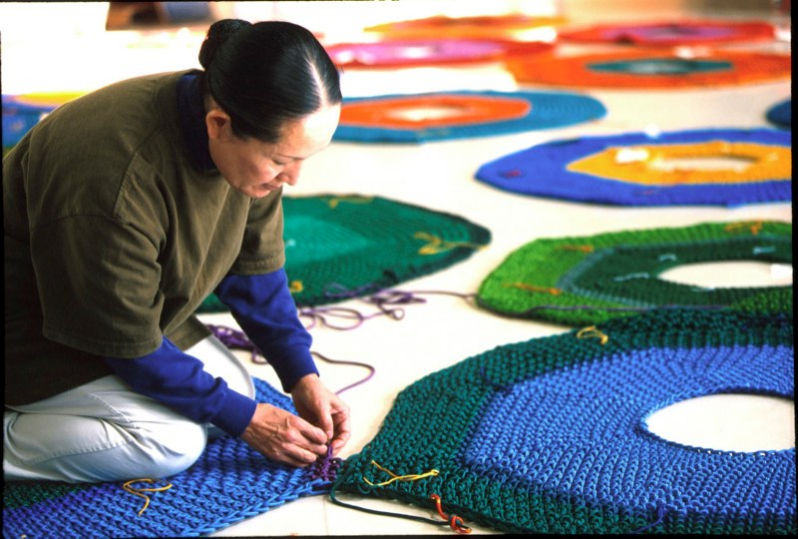Via archdaily.com by Vanessa Quirk:

Wonder Space II, by Toshiko Horiuchi MacAdam and Interplay, at Hakone Open Air Museum. Photo © Masaki Koizumi.
In a world of “dumbed-down,” down-right boring playgrounds, the colorful, architectural masterpieces of Toshiko Horiuchi MacAdam stand apart. The Japanese artist knits her amazing projects by hand – her most famous project, for example, inside the “Woods of Net” Pavilion at the Hakone Open Air Museum in Japan, took her about a year to complete.

Toshiko Horiuchi created this amazing playgroud through crochet. It is located in the children’s area of the Takino Suzuran Hillside National Park in Sapporo, Japan. Click on the picture for more info and pictures.
In 2012, Archdaily spoke with Ms. Horiuchi MacAdam about the Pavilion and her other works, how they bridge the worlds of art and architecture, and how they irresistibly invite the world to play. The full interview is posted here.

“Fibre Columns / Romanesque Church”. Materials: Nylon. Techniques: Hand Knitting, Crochet. Location: Musee Jean Lurcat de la tapisserie contemporaine, Angers, France. © Toshiko Horiuchi Macadam.
AD: Some of your earlier works, such as “Fibre Columns / Romanesque Church,” are very architectural in nature – were you inspired early on by architecture? How so?
When I was a student at Tama Fine Art University in Tokyo, we were introduced to the work of Antonio Gaudi by a professor of architecture. Eventually, in my late 20′s, I traveled to Europe and the Middle East. Of course, I went to Spain to see Gaudi’s work. I also traveled to Isfahan in Iran in particular to look at mosques. Both impressed me a great deal. Antonio Gaudi’s work, as you know, is based on studies of ‘naturally’ curved forms (catenaries) as determined by gravity, turned upside down.
AD: All of your work is hand-made: how does that fact change your relationship to the structures you create?
THM: My works are mostly made by hand, but in certain pieces (our ‘SpaceNet’ play environments, for example, as well as ‘Luminous’ a theatrical stage curtain – I have incorporated a mechanically knotted net). However, it begins from my hands.
AD: Your structures are intriguing to adults and children because they are so interactive. What motivated the decision to get your structures out of the gallery and into the real world?
As an artist I had been exhibiting my work in museums and galleries. At the same time, I was searching: what do I value in life? Who am I? Why do I create these works? Why do I pour so much energy into my work? Throughout this time I created a few works of importance, but at heart I was not fully satisfied. One day I was exhibiting a 3-dimensional open-work textile sculpture I had created in collaboration with a friend. Some children came to the gallery and climbed into it. Suddenly the piece came to life. My eyes were opened. I realized I wanted just such a connection between my work and people alive at this moment in time (not a hundred years from now). I realized I was in fact making works for children. It was an exciting moment for me.
AD: Would you agree that a great playscape is one that allows children to take risks? Would you consider your structures risk-encouraging environments?
I agree. Children need to cope with risk. They enjoy a challenge but by nature are very careful. Presented with a play structure which does not challenge them, they quickly grow bored… and then break them. If you give them a challenging play environment, well designed so children can assess risk, they will not get hurt. Our structures encourage children to challenge themselves but with many routes and options. There is no program of play. There are always alternatives. Each child plays at the level he or she is comfortable with.





Comments (0)